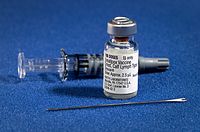
Photo from wikipedia
Powder-injectors use gas propulsion to deposit lyophilised drug or vaccine particles in the epidermal and sub epidermal layers of the skin. We prepared dry-powder (Tg = 45.2 ± 0.5°C) microparticles… Click to show full abstract
Powder-injectors use gas propulsion to deposit lyophilised drug or vaccine particles in the epidermal and sub epidermal layers of the skin. We prepared dry-powder (Tg = 45.2 ± 0.5°C) microparticles (58.1 μm) of a MenY-CRM197 glyconjugate vaccine (0.5% wt.) for intradermal needle-free powder injection (NFPI). SFD used ultrasound atomisation of the liquid vaccine-containing excipient feed, followed by lyophilisation above the glass transition temperature (Tg’ = − 29.9 ± 0.3°C). This resulted in robust particles (density~ 0.53 ±0.09 g/cm3) with a narrow volume size distribution (mean diameter 58.1 μm, and span = 1.2), and an impact parameter (ρvr ~ 11.5 kg/m·s) sufficient to breach the Stratum corneum (sc). The trehalose, manitol, dextran (10 kDa), dextran (150 kDa) formulation, or TMDD (3:3:3:1), protected the MenY-CRM197 glyconjugate during SFD with minimal loss, no detectable chemical degradation or physical aggregation. In a capsular group Y Neisseria meningitidis serum bactericidal assay (SBA) with human serum complement, the needle free vaccine, which contained no alum adjuvant, induced functional protective antibody responses in vivo of similar magnitude to the conventional vaccine injected by hypodermic needle and syringe and containing alum adjuvant. These results demonstrate that needle-free vaccination is both technically and immunologically valid, and could be considered for vaccines in development.
Journal Title: PLoS ONE
Year Published: 2017
Link to full text (if available)
Share on Social Media: Sign Up to like & get
recommendations!